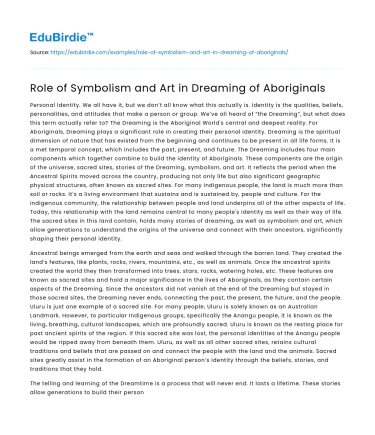Personal Identity. We all have it, but we don’t all know what this actually is. Identity is the qualities, beliefs, personalities, and attitudes that make a person or group. We’ve all heard of “the Dreaming”, but what does this term actually refer to? The Dreaming is the Aboriginal World's central and deepest reality. For Aboriginals, Dreaming plays a significant role in creating their personal identity. Dreaming is the spiritual dimension of nature that has existed from the beginning and continues to be present in all life forms. It is a met temporal concept, which includes the past, present, and future. The Dreaming includes four main components which together combine to build the identity of Aboriginals. These components are the origin of the universe, sacred sites, stories of the Dreaming, symbolism, and art. It reflects the period when the Ancestral Spirits moved across the country, producing not only life but also significant geographic physical structures, often known as sacred sites. For many Indigenous people, the land is much more than soil or rocks. It’s a living environment that sustains and is sustained by, people and culture. For the indigenous community, the relationship between people and land underpins all of the other aspects of life. Today, this relationship with the land remains central to many people's identity as well as their way of life. The sacred sites in this land contain, holds many stories of dreaming, as well as symbolism and art, which allow generations to understand the origins of the universe and connect with their ancestors, significantly shaping their personal identity.
Ancestral beings emerged from the earth and seas and walked through the barren land. They created the land’s features, like plants, rocks, rivers, mountains, etc., as well as animals. Once the ancestral spirits created the world they then transformed into trees, stars, rocks, watering holes, etc. These features are known as sacred sites and hold a major significance in the lives of Aboriginals, as they contain certain aspects of the Dreaming. Since the ancestors did not vanish at the end of the Dreaming but stayed in those sacred sites, the Dreaming never ends, connecting the past, the present, the future, and the people. Uluru is just one example of a sacred site. For many people, Uluru is solely known as an Australian Landmark. However, to particular Indigenous groups, specifically the Anangu people, it is known as the living, breathing, cultural landscapes, which are profoundly sacred. Uluru is known as the resting place for past ancient spirits of the region. If this sacred site was lost, the personal identities of the Anangu people would be ripped away from beneath them. Uluru, as well as all other sacred sites, retains cultural traditions and beliefs that are passed on and connect the people with the land and the animals. Sacred sites greatly assist in the formation of an Aboriginal person’s identity through the beliefs, stories, and traditions that they hold.
Save your time!
We can take care of your essay
- Proper editing and formatting
- Free revision, title page, and bibliography
- Flexible prices and money-back guarantee
The telling and learning of the Dreamtime is a process that will never end. It lasts a lifetime. These stories allow generations to build their personal identities and understand the creation of the world and the laws. Aboriginals are able to keep these stories alive through the use of symbolism and art which can be found within sacred sites. This can come in many modes. For example, symbolism and art can be shown through kinship, song, dance, art, rituals, paintings, and stories. The Aborigines have used imaginative designs and symbols for thousands of years to communicate stories and messages that are incredibly important in their culture. Collins Jones who is an Aboriginal said “art documents our belonging, our belonging to the land, the importance of the land because in aboriginal culture it’s not just the land, it’s what’s on the land and in the land, we become one with the land, so we understand the animals, the plants, the birds, the fish. We know when they migrate where they live when to hunt. So everything is part of a structure and a system that we need to understand and so symbolism and art help to document that history” Collins Jones demonstrates the way that symbolism and art have affected him as an individual and have assisted in the creation of his personal identity. Symbolism and art are ways that Aboriginals keep the dream alive and existing. They are able to do this through the use of the land and the way that they use this. Furthermore, symbolism and art allow Aboriginals to continue to learn and document their dreaming, through the way that they use the land and the resources that this gives off. By doing this, their personal identities are then formed.
Conclusion:
The Dreaming helps Aboriginal people to understand their place in society and nature and link their past spiritual world with the present and the future, creating a meta-temporal concept. The identities of Aboriginals are created and built up through dreaming and the different aspects that this idea contains. This consists of stories of dreaming, the origins of the universe, sacred sites, and symbolism and art. Together these significantly assist in the creation of an Aboriginals personal identity, as traditions and beliefs, which are shared through stories of the dreaming, symbolism, art, and sacred sites, connect people to the land and explain the origins of the universe, which then significantly assists shaping an Aboriginals identity.






 Stuck on your essay?
Stuck on your essay?

